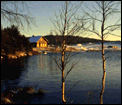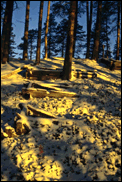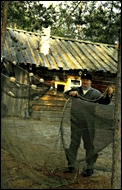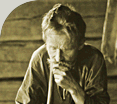
|
 |
|
 The
Tšasouna wood, where a traditional tšasouna (Orthodox
chapel) was completed in the beginning of 2000s. A photograph of
the tšasouna taken by Samuli Paulaharju has survived, and parts
of the structure can also be seen in one of the pictures taken by
I.K. Inha. Using these pictures, the Folklore Villages Project was
able to have a set of plans made for the tšasouna. Construction
began in the autumn of 1997. Through the 1920s, the pine wood was
the site of the traditional Pohrottša Day (27 August) ceremony
in which a ram was sacrificed on the steps of the tšasouna.
The meat was boiled in pots, and only men were permitted to eat
it. The
Tšasouna wood, where a traditional tšasouna (Orthodox
chapel) was completed in the beginning of 2000s. A photograph of
the tšasouna taken by Samuli Paulaharju has survived, and parts
of the structure can also be seen in one of the pictures taken by
I.K. Inha. Using these pictures, the Folklore Villages Project was
able to have a set of plans made for the tšasouna. Construction
began in the autumn of 1997. Through the 1920s, the pine wood was
the site of the traditional Pohrottša Day (27 August) ceremony
in which a ram was sacrificed on the steps of the tšasouna.
The meat was boiled in pots, and only men were permitted to eat
it.
The Pohrottša Day ceremony has been celebrated again annually
since 1992.
|
 Vihtoora's
house was 100 years old in autumn 1994. The man who built the
house and his family were photographed by Inha on his visit to Venehjärvi.
K.F. Karjalainen thought that he had found in Vihtoora one of the
great undiscovered bards, but the poems Vihtoora sung for him were
verses from the Kalevala, not authentic folk poetry. Vihtoora, who
was illiterate, had heard people reading the Kalevala in his business
travels to Finland and had committed what he heard to memory. Vihtoora's
house was 100 years old in autumn 1994. The man who built the
house and his family were photographed by Inha on his visit to Venehjärvi.
K.F. Karjalainen thought that he had found in Vihtoora one of the
great undiscovered bards, but the poems Vihtoora sung for him were
verses from the Kalevala, not authentic folk poetry. Vihtoora, who
was illiterate, had heard people reading the Kalevala in his business
travels to Finland and had committed what he heard to memory. |
|
Hökkälä house
 This
house, the oldest in Venehjärvi, was built by Hökkä-Petri
in 1813, and was where I.K. Inha and K.F. Karjalainen stayed while
in the village. At the time of their visits, the master of this
house, considered the wealthiest in the village, was Hökkä-Iivana,
whom Inha mistakenly referred to as Petri in the caption of his
photograph. This
house, the oldest in Venehjärvi, was built by Hökkä-Petri
in 1813, and was where I.K. Inha and K.F. Karjalainen stayed while
in the village. At the time of their visits, the master of this
house, considered the wealthiest in the village, was Hökkä-Iivana,
whom Inha mistakenly referred to as Petri in the caption of his
photograph.
When they came to the house for the first time, Inha and Karjalainen
were mystified when their host disappeared in mid evening. In the
morning they learned that he had rowed the 15 km to Vuokkiniemi
by night to get tea and sugar for his guests. The entire village
was so poor that not a single person had such luxuries on hand.
Ilmari Kianto also stayed with Iivana in Hökkälä when travelling
in Viena.
|
|
Kalmisniemi
 This
graveyard in Venehjärvi is one of the most impressive in Viena.
Unfortunately, much of it was damaged or destroyed in the 1950s
and 1960s when factory workers from nearby Kemi, sent to the village
to cut hay, stole icons and tore down crosses and wooden shelters
on the graves for firewood. The village was vacant at the time,
but hay was cut there for the cattle on the collective farm in Vuokkiniemi. This
graveyard in Venehjärvi is one of the most impressive in Viena.
Unfortunately, much of it was damaged or destroyed in the 1950s
and 1960s when factory workers from nearby Kemi, sent to the village
to cut hay, stole icons and tore down crosses and wooden shelters
on the graves for firewood. The village was vacant at the time,
but hay was cut there for the cattle on the collective farm in Vuokkiniemi.
|
Pajaniemi point
 This
point of land was the site of the village smithy for centuries. The
present building was built in the 1970s from a 100-year-old granary,
which in Inha's photograph can be seen complete except for the roof. This
point of land was the site of the village smithy for centuries. The
present building was built in the 1970s from a 100-year-old granary,
which in Inha's photograph can be seen complete except for the roof. |
|
Venehjärvi
Vienansalo
What to see
Panorama
Audio sample
|
|

 Vihtoora's
house was 100 years old in autumn 1994. The man who built the
house and his family were photographed by Inha on his visit to Venehjärvi.
K.F. Karjalainen thought that he had found in Vihtoora one of the
great undiscovered bards, but the poems Vihtoora sung for him were
verses from the Kalevala, not authentic folk poetry. Vihtoora, who
was illiterate, had heard people reading the Kalevala in his business
travels to Finland and had committed what he heard to memory.
Vihtoora's
house was 100 years old in autumn 1994. The man who built the
house and his family were photographed by Inha on his visit to Venehjärvi.
K.F. Karjalainen thought that he had found in Vihtoora one of the
great undiscovered bards, but the poems Vihtoora sung for him were
verses from the Kalevala, not authentic folk poetry. Vihtoora, who
was illiterate, had heard people reading the Kalevala in his business
travels to Finland and had committed what he heard to memory.  This
point of land was the site of the village smithy for centuries. The
present building was built in the 1970s from a 100-year-old granary,
which in Inha's photograph can be seen complete except for the roof.
This
point of land was the site of the village smithy for centuries. The
present building was built in the 1970s from a 100-year-old granary,
which in Inha's photograph can be seen complete except for the roof. The
Tšasouna wood, where a traditional tšasouna (Orthodox
chapel) was completed in the beginning of 2000s. A photograph of
the tšasouna taken by Samuli Paulaharju has survived, and parts
of the structure can also be seen in one of the pictures taken by
I.K. Inha. Using these pictures, the Folklore Villages Project was
able to have a set of plans made for the tšasouna. Construction
began in the autumn of 1997. Through the 1920s, the pine wood was
the site of the traditional Pohrottša Day (27 August) ceremony
in which a ram was sacrificed on the steps of the tšasouna.
The meat was boiled in pots, and only men were permitted to eat
it.
The
Tšasouna wood, where a traditional tšasouna (Orthodox
chapel) was completed in the beginning of 2000s. A photograph of
the tšasouna taken by Samuli Paulaharju has survived, and parts
of the structure can also be seen in one of the pictures taken by
I.K. Inha. Using these pictures, the Folklore Villages Project was
able to have a set of plans made for the tšasouna. Construction
began in the autumn of 1997. Through the 1920s, the pine wood was
the site of the traditional Pohrottša Day (27 August) ceremony
in which a ram was sacrificed on the steps of the tšasouna.
The meat was boiled in pots, and only men were permitted to eat
it. This
house, the oldest in Venehjärvi, was built by Hökkä-Petri
in 1813, and was where I.K. Inha and K.F. Karjalainen stayed while
in the village. At the time of their visits, the master of this
house, considered the wealthiest in the village, was Hökkä-Iivana,
whom Inha mistakenly referred to as Petri in the caption of his
photograph.
This
house, the oldest in Venehjärvi, was built by Hökkä-Petri
in 1813, and was where I.K. Inha and K.F. Karjalainen stayed while
in the village. At the time of their visits, the master of this
house, considered the wealthiest in the village, was Hökkä-Iivana,
whom Inha mistakenly referred to as Petri in the caption of his
photograph. This
graveyard in Venehjärvi is one of the most impressive in Viena.
Unfortunately, much of it was damaged or destroyed in the 1950s
and 1960s when factory workers from nearby Kemi, sent to the village
to cut hay, stole icons and tore down crosses and wooden shelters
on the graves for firewood. The village was vacant at the time,
but hay was cut there for the cattle on the collective farm in Vuokkiniemi.
This
graveyard in Venehjärvi is one of the most impressive in Viena.
Unfortunately, much of it was damaged or destroyed in the 1950s
and 1960s when factory workers from nearby Kemi, sent to the village
to cut hay, stole icons and tore down crosses and wooden shelters
on the graves for firewood. The village was vacant at the time,
but hay was cut there for the cattle on the collective farm in Vuokkiniemi.